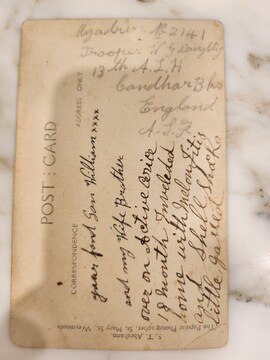DOUGHTY, William Griffin
| Service Number: | 2141 |
|---|---|
| Enlisted: | Not yet discovered |
| Last Rank: | Private |
| Last Unit: | 13th Light Horse Regiment |
| Born: | Not yet discovered |
| Home Town: | Not yet discovered |
| Schooling: | Not yet discovered |
| Occupation: | Not yet discovered |
| Memorials: | Tumbarumba District Roll of Honour WW1 |
World War 1 Service
| 6 Dec 1916: | Involvement Private, 2141, 13th Light Horse Regiment, --- :embarkation_roll: roll_number: '3' embarkation_place: Melbourne embarkation_ship: HMAT Orsova embarkation_ship_number: A67 public_note: '' | |
|---|---|---|
| 6 Dec 1916: | Embarked Private, 2141, 13th Light Horse Regiment, HMAT Orsova, Melbourne |
William Doughty
William Griffin Doughty was born on the 23 August, 1891, in the town of Tumbarumba, New South Wales. At the time of his birth his father, Robert William Doughty (1857 to 1936) was 34 and his mother, Sarah Ann, nee Griffiths (1864 to 1946), was 27. He had 6 brothers and sisters who were Stanley Gordon Doughty (1894 to 1982), Wallace Bertie Doughty (1896 to 1979), Septimus Angel Doughty (1899 to 1983), Christina Ellen Doughty (1901 to 1966), Lena A Doughty (1904 to 2001) and Donald Matthew Doughty (1906 to 1972).
William married Mary Agnes nee Linnane (1898 to 1971) in 1914 and they had two children together. Their names were Mabel Alice Doughty (1915 to 1921) and Edward William Doughty (1918 to 1940).
Four of William’s brothers also enlisted in the AIF, although at earlier dates than William. At enlistment, William was a 23 year old labourer who was married with one child, a daughter Mabel. He was 165 cm tall and weighed 60 kg with a chest measurement of 82 cm. According to his enlistment papers, William’s hair was brown as was his eyes and he had a fair complexion. His religious denomination was given as Church of England. His attestation papers include a note that mentions previous service in the AIF for a period of 146 days before being discharged as medically unfit. There is no further evidence of this period of service in his record and it leads us to wonder when and where he served.
William was taken on strength with the 15th Reinforcements of the 13th Light Horse Regiment on the 21 October, 1916, and given the service number 2141. He embarked on HMAT A67 Orsova on the 6 December, 1916, at Melbourne, Victoria. He would disembark at Plymouth in England on the 17 February, 1917. One day later he marched into the 13th Light Horse Regiment stationed at Kandahar Barracks in Tidworth.
William was still in England when he was admitted sick to the Sydney Hall Hospital at Weymouth on 10 April, 1917. He would remain here for a period of three months, marching out to the No. 8 Convalescent Depot at Hurdcott. William’s illness lead to him being reclassified as B1 on the 29 July, which meant that he was able to undertake Garrison duties abroad. Two weeks later, he was reclassified as C1, fit for Garrison Service at Home Camps. A note in his medical record indicates that the reclassification was due to a general disability after suffering from CSM. CSM (cervical spondylotic myelopathy) is a nervous system disorder of the spinal cord that causes pain and difficulty in walking.
On the 27 August, he embarked on HMAT A82 New Zealand to return to Australia. He was discharged medically unfit on the 30 November, 1917. For his service during the war he was awarded the British War Medal and the Victory Medal.
Electoral roll records indicate that William lived in both the Corryong and Tumbarumba areas of the Upper Murray. He passed away on the 8 August, 1969, in Albury, New South Wales when he was 77 years old.
Extract from "Light Horsemen of the Upper Murray", Year 5 and 6 Project, Corryong College.
Submitted 20 April 2019 by Stephen Learmonth











